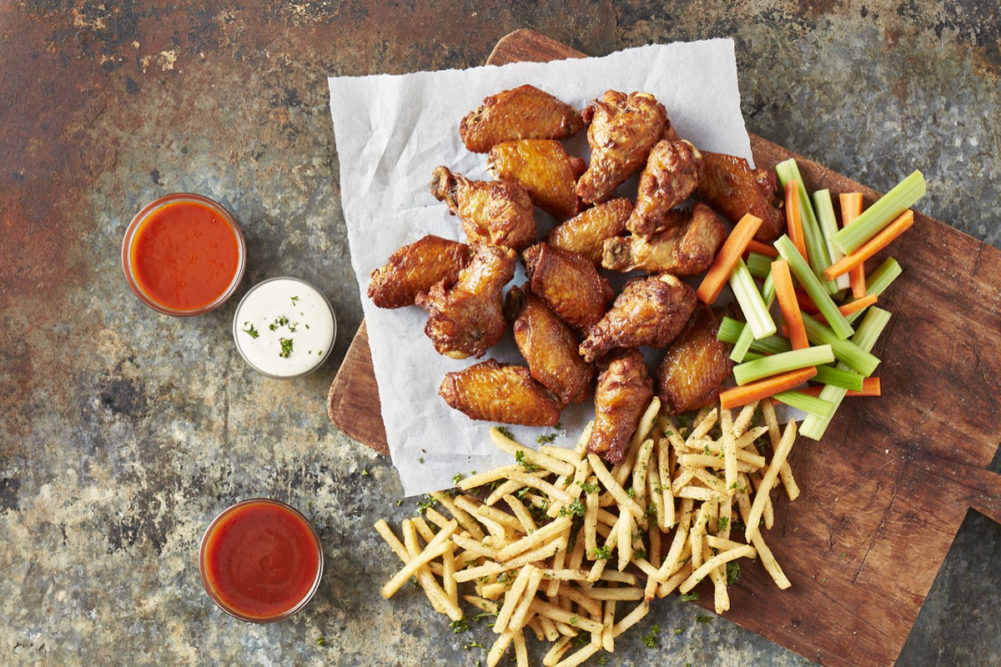Wing sales at grocery deli/prepared had already been growing, thanks to Americans’ busy schedules and pandemic-related trends in the direction of convenience and prepared foods, said Tom Bell, vice president of prepared foods sales for Oakwood, Ga.-based Wayne-Sanderson Farms.
Then came inflation, which made demand jump even more.
“The market for wings is hotter than ever,” Bell said. “Wing bars are expanding, and our product line fits well into the category.”
The average person eats about 290 wings a year, Bell said. And Super Bowl consumption jumped from $1.4 billion in 2022 to $1.5 billion in 2023.
Wings are a huge, ever-growing success for a number of reasons, Bell said:
- Great flavor;
- Flexible/adaptable to many different seasonings and prep methods;
- Easy to prep and serve: and
- They “travel well” for mobile lifestyles/activities, e.g. sports events, tailgates and picnics.
Whether they’re breaded, unbreaded, steamed or marinated, wings are doing well in all formats, and retail grocery is no exception, Bell said.
And with that growth has come more experimentation.
“Flavors and tastes are changing—beyond buffalo, lemon-pepper and parmesan. Chefs and consumers are taking great liberties with wings, opting for bold flavors like habanero/pineapple, along with cultural fusion — from Asian, Cali-Baja, Korean and Thai influences, with sweet-hot flavors leading the pack.”
The new chicken wing production line that Wayne-Sanderson rolled out in 2022 has given the company 50 million pounds of new capacity, Bell said.
And the use of robotics in packout has helped reduce its labor challenges.
“The state-of-the-art equipment allows for consistent, high quality products that our customers require and deserve,” Bell said.
The new production line makes it easier than ever, he added, for Wayne-Sanderson to provide custom wing products for its customers as well as its own WSF Flyers, Buffaloos and — new to the mix — Flying Saucers.
Several industry trends that Wayne-Sanderson is keeping on top of are helping to ensure the success of deli/prepared programs, Bell said.
“The use of fully cooked wings has allowed a quicker recon time in the back of house as well and hot deli. Steam cooking locks in the moisture often missing in a fresh wing, and our use of only fresh wings in our operation helps to reduce black bone occurrences after cooking.”
Another aspect of its wing division that has helped Wayne-Sanderson deliver top quality its customers is the company’s Customer Innovation Center, Bell said.
Paired with its pilot plant and new dedicated production lines, the Customer Innovation Center lets Wayne-Sanderson take ideas and concepts from a customer ideation session right into pilot production and then to scale.
And the merger of Wayne Farms and Sanderson Farms has itself been a boon for meeting the ever-growing demand for wings at retail, Bell said.
“We’re a larger company now with more resources, able to bring more to the table for customers in terms of volumes, variety and value.”
The real Super Bowl champ
Kansas City is famous for barbecue, Philadelphia for cheesesteaks.
But the cities whose teams clashed in this year’s Super Bowl still can’t compete with the hands-on Big Game champion: chicken wings.
About 1.45 billion wings were eaten during Super Bowl weekend, according to the National Chicken Council’s annual estimate. That’s 2% — or 84 million wings — more than last year.
There are several reasons for the uptick, said National Chicken Council spokesperson Tom Super.
“The two main reasons are more favorable prices and more people getting back to normal and gathering for the Big Game, whether at home or at a bar/restaurant,” Super said. “While Americans are seeing inflation impact almost every part of their lives, both wholesale and retail wing prices are down double digits from a year ago, according to USDA, and consumers are seeing a lot more features and promotions.”
There were a lot of great story lines heading into this year’s game, Super added.
“Andy Reid versus his old team. A battle of the Kelce brothers. Mahomes versus Hurts. But no Super Bowl story line is hotter than wings.”
Big games inspire gatherings, and wings are on the menu. When comparing the week ending Jan. 22 to the week ending Jan. 8 (the final week of the regular NFL season), wing sales grew double digits in both dollars (+11.5%) and pounds sold (+13.5%) within the Kansas City, Philadelphia, San Francisco and Cincinnati markets, according to IRI OmniMarket Integrated Fresh).
Picture this
1.45 billion wings laid end to end would stretch from GEHA Field at Arrowhead Stadium in Kansas City, Mo., to Lincoln Financial Field in Philadelphia, about 62 times.
Enough to give four wings each to every man, woman and child in the United States.
Phoenix’s State Farm Stadium (home of Super Bowl LVII) can hold 73,000 people. If 1.45 billion chicken wings were distributed to the full stadium, each fan could enjoy 19,863 wings.
Assuming Kansas City Chiefs’ coach Andy Reid can eat three wings per minute, it would take him more than 900 years to eat 1.45 billion wings.

